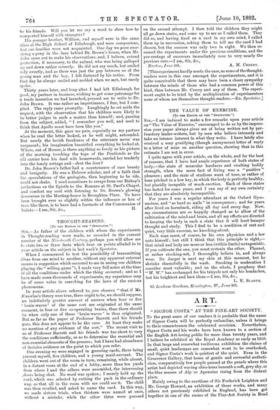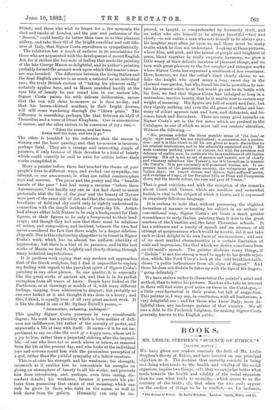ART.
"SIGNOR COSTA" AT THE FINE-ART SOCIETY. To the great mass of our readers it is probable that the name of Signor Costa will be perfectly unfamiliar, unless it brings to their remembrance the celebrated musician. Nevertheless, Signor Costa and his works have been known to a section of the English Art-loving public for more than twenty years, and. I believe he exhibited at the Royal Academy as early as 1859. In that large and somewhat vociferous exhibition the claims of small, quiet landscapes are somewhat wont to be overlooked, and Signor Costa's work is quietest of the quiet. Even in the Grosvenor Gallery, that home of gentle and sorrowful testheti- cism, comparatively few people paused at the panels where this artist had depicted waving olive-trees beneath a soft, grey sky, or the blue masses of Alp- or Apennine rising from the distant plain.
Mainly owing to the exertions of Sir Frederick Leighton and Mr. George Howard, an exhibition of these works, and. many others not -previously exhibited. in England, has been got together at one of the rooms of the Fine-Art Society in Bond. Street; and those who wish to forget for a few moments the dust and smoke of London, and the jam and jealousies of the "Season," could hardly do better than turn in to this pleasant gallery, and take their fill of the bright sunshine and soft idle- ness of Italy, that Signor Costa reproduces so sympathetically.
The exhibition has a touch of sadness in its associations for those who are acquainted with the development of recent English Art, for it strikes the key-note of feeling that made the painting of the late George Mason so delightful, and its author's painting probably formed the ground-work upon which that master's man- ner was founded. The difference between the living Italian and the dead English painter is as much a national as an individual one ; the truly British custom of "taking his pleasure sadly" certainly applies here, and as Mason snatched hastily at the rare bits of beauty he saw round him in oar narrow isle, Signor Costa paints his with delicate deliberation, secure that the sun will shine to-morrow as it does to-day, and that his brown-skinned maidens, in their bright dresses, will still come wandering through the "blown grass." The difference is something, perhaps, like that between an idyll of Theocritus and a verse of Omar Khayham. One is unconscious of sorrow, and the other strives to be conscious of joy ; one,—
" Takes the season, and has done,
Loves well the hour, and lets it go."
The other is troubled by the reflection that the season is waning and the hour passing, and that to-morrow is insecure, perhaps fatal. They are a strange and interesting couple of painters, if only because of their devotion to a kind of beauty which could scarcely be said to exist for artists before their works exemplified it.
Many a painter before these had touched the theme of poor people's lives in different ways, and evoked our sympathy, our interest, or our amusement, in what are called common-plade joys and sorrows. The prose and the poetry and the "humble annals of the poor" had had many a recorder "before these Agamemnons," but hardly any one in Art had dared to assert pictorially that the life of the poor and the beauty of Nature were part of the same side of Art, and that the meaning and the loveliness of field and sky could only be rightly understood in connection with the simple incidents of every-day life. Artists had always either held Nature to be only a background for their 'figures, or their figures to be only a foreground to their land- scape; and though they had seen that there must be relations of action, and composition, and incident, between the two, had never considered the fact that there might be a deeper relation- ship still. Nor is this relationship altogether to be found in Signor Costa's work, which has an almost. too uniform placidity of impression ; but there is a hint of its presence, and in the best works of Mason we find it, brightly and clearly shining, through many technical imperfections.
It is perilous work saying that any modern art approaches that of the Greek sculptors, but I find it impossible to explain my feeling with regard to the prevalent spirit of Signor Costa's painting in any other phrase. In one quality, it is especially like the great works of ancient art, and that is in its perfect exemption from all traces of haste. People have looked at the Parthenon, or at drawings or models of it, with many different feelings, ranging from admiration to disgust ; but probably no one ever looked at it and thought it was done in a hurry ; and this, I think, is equally true of all very great ancient work. It is like the cloud in one of Mr. Sydney Dobell's poems,—
" Immaculate, unhasting, undelayed."
This quality Signor Costa possesses in very considerable -degree; his work has a placidity which is born neither of dull- ness nor indifference, but rather of the serenity of power, and apparently a life at ease with itself. It seems—if it be not im- pertinent to say so—like the work of a happy man, whose art is a joy to him, rather than a perpetual striving after the irnpossi-
ide,—of one who lives not so much above or below, as removed from the life of the present day, and who looks at the individual joys and sorrows round him with the passionless perception of a god, rather than the painful sympathy of a fellow-creature.
This is at once his strength and his weakness ; his strength, insomuch as it enables him to concentrate his energies on giving an atmosphere of beauty to all his works, and prevents him from introducing, and, perhaps, even from seeing, dis- cordant details ; his weakness, because it prevents his pic- tures from possessing that strain of real meaning, which can only be given by those who fight in the arena, as well as 400k down from the gallery. Humanity can only be im- proved, or taught, or comprehended by humanity itself, and an artist who sets himself to be always beautiful—first and chiefly—is not unlike a man who sets himself to be always gay ; his laughter must often jar upon us, and there must be many truths which he does not understand. Looking at these pictures, where blue, and pink, and the fairest of purple and brightest of green, blend together in really exquisite harmony, we .grow a little weary of their delicate iteration of pleasant things, and we turn with great pleasure to the few rougher and stronger works where Signor Costa has expressed a sentiment of less sweetness. Here, however, we find the artist's limit clearly shown to us. Like the knight who spent many a long, sweet day in the charmed rose-garden, but who found his limbs powerless to sus- tain his armour when he at last would go out to do battle with his foes, we find that Signor Costa has indulged so long in a motionless, inactive beauty, that he is unable now to sustain any weight of meaning. His figures are full of sound and fury, but they signify nothing, and even the old grace of outline and har- mony of colour appears bent and torn, and distracted, and be- comes harsh and discordant. There are many good remarks on Signor Costa's art in the few notes which are prefixed to the Catalogue, to one of which we must call our readers' attention. Witness the following :—
"His, pictures exhibit the finest possible sense of the line,' or style—style reached, but not emphasised ; a possession, not a preten- sion—and it is this which in all his art gives so much distinction to his original impressions, and to his admirably-sustained study. His work contains nothing quaint or curious, but with the precision and delicacy of earlier men, he continues the best traditions of old Italian painting. His art is not an art of passion and tumult, nor of cloudy and visionary splendour like Turner's, nor is it tremulous in manner like Corot's. It is pre eminently self.possessed Italian art. It ex- presses much of the passionless serenity, the voluptuous peace of Italian days; the limpid dawns, and denser, light-suffused noons, still evenings of Capri, of the Perugian hills, or Pisan and Campanian shore, and the blonde colour, the rose and grey of Venice."
That is good criticism, and with the exception of the remarks about Corot and Turner, which are needless and somewhat foolish, is vital to the subject of which it treats, and is expressed in singularly felicitous language.
It is curious to note that, without possessing the slightest formalism of manner or treating his subject in an archaic or conventional way, Signor Costa's art bears a much greater resemblance to early Italian painting than it does to the great masters of the Venetian and the later Florentine schools. It has a reticence and a purity of speech and an absence of all attempt at gorgeousness which would be ascetic, did it not take such evident delight in its own form of sensuousness ; and one of its most marked characteristics is a certain limitation of scale and impression, like that which we derive sometimes from.
an old maid's speech. The painter disdains many things, if " disdain " is not too strong a word to apply to his gentle rejec- tion, which, like Fred Vincy's look at the cold breakfast-table, shows "a polite forbearance from all signs of disgust." And those he does not disdain he takes up with the tips of his fingers, "going delicately." • We have striven rather to characterise the painter's mind and method, than to notice his pictures. Readers who take an interest in these will find some good notes on them in the Catalogue,— a little over-hysterical in their praise, but full of suggestion. This painter is, I may say, in conclusion, with all limitations, a very delightful one ; and for those who know Italy, more de- lightful than any landscape painter of that country. We all owe a debt to Sir Frederick Leighton, for making Signor Costa generally known to the English public.





































 Previous page
Previous page